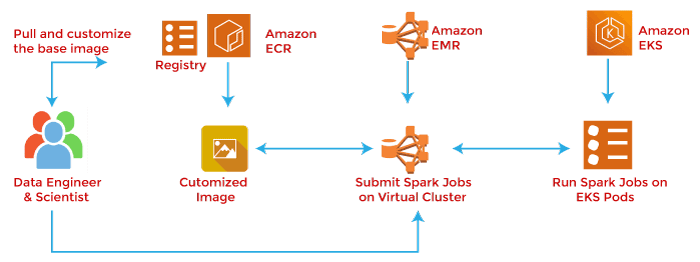What is Amazon EMR?
Amazon Elastic Map Reduce (Amazon EMR) is a web service that makes it easy to process large amounts of data quickly and cost-effectively.
Amazon EMR uses Hadoop, an open-source framework, to distribute your data and processing across resizable clusters of Amazon EC2 instances.
Amazon EMR is used in various applications, including log analysis, web indexing, data warehousing, machine learning, financial analysis, scientific simulation, and bioinformatics. Customers launch millions of Amazon EMR clusters every year.
Amazon EMR (formerly known as Amazon Elastic Map Reduce) is an Amazon Web Services (AWS) tool for big data processing and analysis. Amazon markets EMR as an expandable, low-configuration service that provides the option of running cluster computing on-premises.
Amazon EMR is based on Apache Hadoop, a Java-based programming framework that supports the processing of large data sets in a distributed computing environment. Using Map Reduce, a core component of the Hadoop software framework, developers can write programs that process massive amounts of unstructured data in distributed clusters of processors or standalone computers.
Google developed it to index web pages and replaced its original indexing algorithm and inference in 2004.
Amazon EMR processes big data in Hadoop clusters of virtual servers on Amazon Elastic Compute Cloud (EC2) and Amazon Simple Storage Service (S3).
Elastic in the name of EMR refers to its dynamic resizing capability, which enables administrators to increase or decrease resources based on their current needs.
Amazon EMR is used for log analysis, web indexing, data warehousing, machine learning (ML), financial analysis, scientific simulation, and data analysis in bioinformatics.
It also supports workloads based on Apache Spark, Apache Hive, Presto and Apache HBase, which integrate with Hive and Pig, which are open source data warehouse tools for Hadoop. Hive uses queries and analyzes data, and Pig provides a high-level mechanism for programming Map Reduce jobs to be executed in Hadoop.
Amazon EMR Use Cases
There are many ways enterprises can use Amazon EMR, including:
Machine Learning. EMR’s built-in ML tools use the Hadoop framework to build a variety of algorithms to support decision making, including decision trees, random forests, support vector machines, and logistic regression.
Extract, Convert and Load. ETL is the process of moving data from one or more data stores to another. Data transformation – such as sorting, aggregation and joining – can be done using EMR.
Clickstream Analysis. Amazon S3 clickstream data can be analyzed with Apache Spark and Apache Hive. Apache Spark is an open-source data processing tool that can help make data easier to manage and analyze. Spark uses a framework that enables jobs to be run across large clusters of computers and can process data in parallel. Apache Hive is a data warehouse infrastructure built on top of Hadoop that provides tools to work with data that Spark can analyze. Clickstream analysis can help organizations understand customer behaviour, improve website layout, find out what keywords people use in search engines, and see which Word combinations lead to sales.
Real-time Streaming. Users can analyze events using streaming data sources in real-time with Apache Spark Streaming and Apache Flink. It enables streaming data pipelines to be built on EMR.
Interactive Analytics. EMR Notebook is a managed service that provides a secure, scalable and reliable environment for data analysis.
Using Jupyter Notebook – Open-source web application data scientists can use to create and share live code and equations – data can be prepared and visualized to perform interactive analytics.
Genomics. Organizations can use EMR to process genomic data to make data processing and analysis scalable for industries, including pharmaceutical and telecommunications.
Amazon EMR Deployment Options
As a cloud service, Amazon EMR can be deployed in a variety of settings, such as:
Amazon EMR on Amazon EC2. Using Amazon EC2, Amazon EMR can process large amounts of data quickly. Users can configure Amazon EMR to take advantage of on-demand, reserved and spot instances.
Amazon EMR on Amazon Elastic Kubernetes Service (EKS). Amazon EMR Console enables users to run Apache Spark applications alongside other applications on the same EKS cluster. Organizations can share compute and memory resources across applications and use Kubera to monitor and manage infrastructure.

Amazon EMR features
The features of Amazon EMR are designed to make the following tasks easier and more convenient for administrators and developers:
- EMR Studio. This integrated development environment helps developers write code and is an efficient, easy way to build and test applications. EMR Studio consists of a source code editor, build automation tools, and a debugger.
- Amazon 10-node EMR clusters cost $0.15 per hour, and organizations only pay for the time their cluster runs. They can further control costs by setting up EMR clusters with spot instances, which enable users to bid on additional EC2 capacity and pay only for the resources used.
- EMR separates computation and storage for personal scaling and benefits from Amazon S3’s tiered storage. Instances can process data at any scale and are automatically provisioned, managed and monitored. With AWS Auto Scaling, users can increase or decrease the number of instances based on usage.
- Amazon EMR monitors clusters to ensure optimal resource utilization. It uses the Amazon Cloud Watch service to collect and interpret metrics. Amazon EMR can monitor the cluster’s health, usage, and performance and help identify problematic nodes or jobs. It also provides a load balancer service, which helps direct traffic to healthy nodes automatically.
- The protection. Amazon EMR includes security features, such as automatically configuring the EC2 firewall so that only necessary network traffic is allowed on the instance. Clusters have been launched in the Amazon Virtual Private Cloud. Server-side encryption or client-side encryption can help in managing the keys. Modifies data access control for AWS Lake Formation or Apache Ranger databases.
- Flexibility. Amazon EMR enables users to customize the cluster and install third-party software packages using scripts. Users can also reconfigure the application without launching the cluster.
